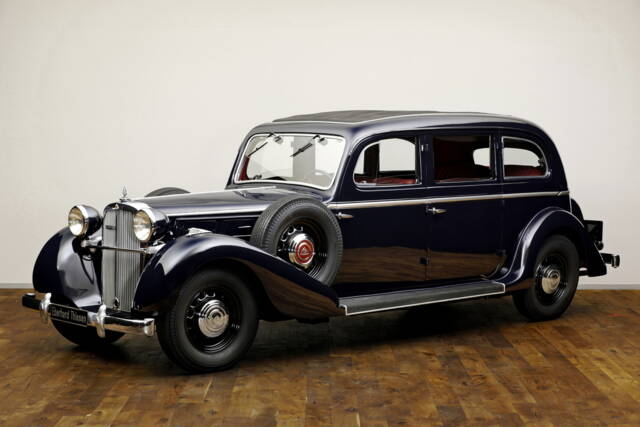- Automobile
- Maybach
- Maybach SW 42 (0 offerte)
Maybach SW 42 : voitures anciennes à vendre
La Maybach SW 42 incarne l'apogée du raffinement automobile allemand des années 1930, combinant innovations techniques avancées et finitions ultra-luxueuses. Cette rare berline est recherchée pour sa qualité de fabrication supérieure et ses performances exceptionnelles pour son époque.
Risultati della ricerca
Attualmente non ci sono annunci corrispondenti alla tua ricerca.
Créer une alerte de recherche
Soyez averti dès qu'une annonce correspondant à vos filtres de recherche est publiée.
Créer l'annonce
Avez-vous un Maybach SW 42 que vous voulez vendre? Alors, créez une annonce maintenant.
Créer l'annonceRéférences d'annonces "Maybach SW 42" de Classic Trader
Vous trouverez ci-dessous des annonces liées à votre recherche qui ne sont plus disponibles sur Classic Trader. Utilisez ces informations pour obtenir un aperçu de la disponibilité, des tendances de valeur et des prix actuels d'une "Maybach SW 42" afin de prendre une décision d'achat plus éclairée.

1939 | Maybach SW 42
Pullman Saloon by Spohn
Créer une alerte de recherche
Soyez averti dès qu'une annonce correspondant à vos filtres de recherche est publiée.
Créer l'annonce
Avez-vous un Maybach SW 42 que vous voulez vendre? Alors, créez une annonce maintenant.
Créer l'annonceHistoire et genèse de la Maybach SW 42
La Maybach SW 42 fut introduite à la fin des années 1930, à une période où Maybach s’imposait comme synonyme d’ingénierie de haute précision pour une clientèle très exclusive. Ce modèle s’inscrit dans la dernière génération des Maybach construites avant la Seconde Guerre mondiale. Pensée pour répondre aux exigences d'une élite, la SW 42 était à l'époque un summum de technologie et de confort, s’adressant principalement à des chefs d’entreprise, de hauts fonctionnaires et des amateurs de voitures d’exception soucieux du moindre détail mécanique et esthétique.
Évolution du modèle et place dans la gamme
La SW 42 conclut la série des berlines SW lancée au début des années 1930 chez Maybach. Précédé par les modèles SW 35, SW 38, la version 42 en reprend l’architecture avec des optimisations majeures sur la motorisation, l’agencement intérieur et les équipements. L’arrêt de production de la SW 42 signe aussi la fin des Maybach classiques d’avant-guerre, la marque ne reprenant la production automobile que de nombreuses décennies plus tard après son rachat par Daimler.
Particularités remarquables et statistiques
La Maybach SW 42 se démarque par son moteur six cylindres en ligne de grand volume, sa transmission avancée pour l’époque et une conception axée sur la souplesse d’utilisation. Les matériaux utilisés, du cuir pleine fleur aux boiseries rares, témoignent du souci du détail propre à la marque. Chaque exemplaire étant fabriqué à la commande, les configurations varient, renforçant l’unicité de chaque véhicule.
D’après nos données, les listings de SW 42 représentent 100 % des annonces Maybach actuellement sur le marché de la collection, la demande suivant la même tendance. Ce monopole reflète la rareté des autres modèles Maybach historiques, rendant la SW 42 le représentant principal pour les amateurs français.
Données techniques détaillées
Éditions spéciales et variantes collectables
Certains exemplaires de la SW 42 furent confiés à de grands carrossiers comme Spohn ou Erdmann & Rossi, recevant des carrosseries sur-mesure qui aujourd'hui se distinguent particulièrement sur le marché des véhicules de prestige. Ces variantes, plus rares encore, sont très prisées pour leurs finitions uniques et leurs spécificités de commande d’époque.
Entretien et points sensibles
L’entretien de la SW 42 exige un savoir-faire exceptionnel. Les pièces mécaniques, en particulier la distribution et les composants spécifiques de la transmission Maybach, nécessitent un suivi régulier et des pièces difficilement trouvables. Les boiseries intérieures et les selleries originales demandent une attention constante face à l’humidité et au vieillissement. Il est essentiel de confier l’auto à des spécialistes connaissant la technologie pré-Seconde Guerre mondiale.
Moteur, transmission et comportement routier
Le moteur six cylindres de la SW 42 impressionne par son couple élevé dès les bas régimes et un fonctionnement étonnamment doux pour les standards d’avant-guerre. La transmission apporte une souplesse et un agrément de conduite rare pour un véhicule aussi imposant. Au volant, la SW 42 affiche une tenue de route sécurisante, même sur longues distances, et un confort exceptionnel grâce à ses suspensions soigneusement calibrées. - SW 42 Carrosserie Spohn : réputée pour l’architecture aéro-stylée et la personnalisation de l’habitacle
- SW 42 Cabriolet Erdmann & Rossi : exemple parfait de l’alliance entre technologie allemande et raffinement artisanal
Style extérieur, habitacle et finitions
Le design de la Maybach SW 42 synthétise les codes du luxe automobile allemand : lignes étirées, calandre verticale majestueuse, ornements en chrome et boiseries fines. Certains modèles se distinguent par des couleurs personnalisées pour la carrosserie et des intérieurs en cuir précieux. La planche de bord, parfois en loupe de noyer, rassemble des compteurs de précision, témoignant du goût du détail cher à la marque. Les voitures carrossées sur mesure intègrent parfois des sièges inclinables, des cloisons et accessoires d’époque comme des radios embarquées ou des valises assorties.
Autres spécificités intéressantes
Chaque commande de SW 42 pouvait intégrer des accessoires personnalisés selon le standing du propriétaire d’origine : bar embarqué, systèmes audio, réchauffeurs auxiliaires ou dispositifs de maintien pour chapeaux et gants, rappelant l’extrême individualisation propre à Maybach durant cette époque.
Résumé
La Maybach SW 42 s’impose comme la quintessence du savoir-faire automobile allemand de l’entre-deux-guerres. Une mécanique élaborée, un design sur-mesure et une rareté absolue en font une pièce singulière pour amateurs avertis, ceux qui savent apprécier la subtilité mêlée à la puissance d’une berline haut de gamme de cette période.